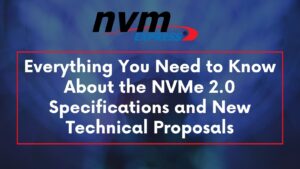
Everything You Need to Know About the NVMe 2.0 Specifications and New Technical Proposals
BlogNVM Express, Inc. recently announced the release of the NVM Express® (NVMe®) 2.0 family of specifications. The NVMe 2.0 specifications were restructured to: enable faster and simpler development of NVMe solutions, and to support the increasingly diverse NVMe device environment. The extensibility of the specifications encourages the ongoing enhancements of independent command sets like Zoned Namespaces (ZNS) and Key Value while enabling support of the various underlying transport protocols common to NVMe and NVMe® over Fabrics (NVMe-oF™) technologies.
In addition to these exciting new features, the release of the NVMe 2.0 specifications includes sequestered technical proposal or TP (not that kind of TP) zip files for NVMe-MI 1.1, NVMe 1.4, and NVMe-oF 1.1 specifications. The previous specifications are now all packaged with significantly more TPs inside.
An Overview of the New TPs
To facilitate the development of the refactored NVMe 2.0 family of specifications, the public release of some NVMe, NVMe-oF, and NVMe-MI technical proposals were delayed (or sequestered). With the release of the NVMe 2.0 family of specifications, NVM Express is pleased to announce that those TPs are now published publicly. The respective TP Zip files of NVMe-MI 1.1, NVMe 1.4, and NVMe-oF 1.1 specifications now include all existing ratified TPs. Apart from TP4097, all these TPs have been integrated into the NVMe 2.0 family of specifications. A TP4097a that is applicable to NVMe 2.0 specification will be released soon. View the updated TPs in the Developers section of the website.
New NVMe 2.0 Specification Features
In addition to releasing sequestered technical proposals from previous specifications, the NVMe 2.0 family of specifications include critical new features like Zoned Namespaces (ZNS), Key Value and Endurance Group Management.
The ZNS specification provides a zoned storage device interface that allows the SSD and host to collaborate on data placement. ZNS permits data to be aligned to the physical media of the SSD, which improves the overall performance and cost while also increasing the capacity that can be made available to the host.
The NVMe Key Value (NVMe-KV) Command Set provides access to data on an NVMe SSD namespace using a key as opposed to a logical block addresses. The NVMe-KV command set allows users to access a variable sized value (e.g., an object) using a key without the overhead of the host maintaining a translation table that defines an object as a sequence of logical block addresses.
Rotational media support has been added to enable use of NVM Express by Hard Disk Drives (HDDs). This includes updates to features, management capabilities and other enhancements required for HDD support.
NVMe Endurance Group Management enables media to be configured into Endurance Groups and NVM Sets. This exposes granularity of access to the SSD and improved control.
The NVMe 2.0 specifications also maintain backwards compatibility with previous NVMe architecture generations.
Learn More About the NVMe 2.0 Specification
To learn more about the NVMe 2.0 family specifications and newly released TPs, read the recent press release and visit the Specifications Library.
We also invite you to follow us on Twitter and LinkedIn to stay up to date on the latest NVMe technology updates.